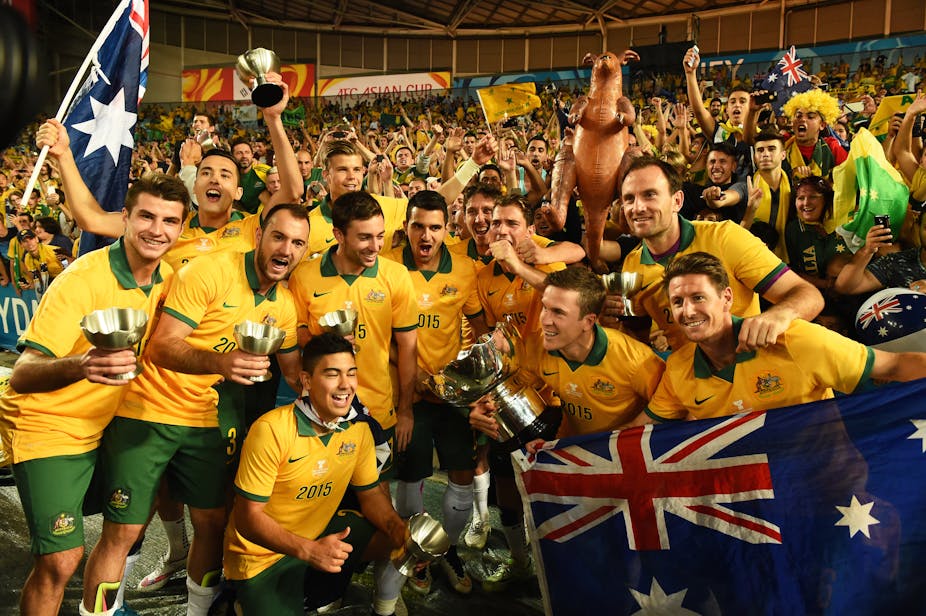In a fitting climax to the 2015 Asian Cup, Australia overcame South Korea in extra-time in a frenetic final in Sydney on Saturday night.
The tournament carried on from the 2014 World Cup in Brazil, which was rated as one of the finest ever. The overall standard of play was high and the atmosphere inside the stadiums on the whole superb.
Ultimately, the first Asian Cup played in Australia achieved significant success across two, intertwining dimensions: sporting and cultural.
High-quality football
The Asian Cup featured an average of 2.66 goals per game, compared to 2.67 at the 2014 World Cup. There was not a single scoreless match. This, as I have pointed out previously, is not in itself definitive of entertaining football. However, it is suggestive of a subtle attitude change over recent years.
As research suggests, the tendency in high-speed modern football is for both condition and concentration to deteriorate in the latter stages of play. This was again evident at the Asian Cup. It’s something that the Australian team under coach Ange Postecoglou was always looking to exploit.
Other outcomes defy explanation. Surprisingly, the knockout phase exceeded the quality of games that had come before. Knockout matches dominated by tactical timidity and player fatigue have bedevilled international tournaments in recent decades. Such games have often come to resemble, to paraphrase Argentinian author Jorge Luis Borges, two bald men fighting over a comb.
Yet, for drama, the Asian Cup quarter-final stage in particular exceeded all expectations.
The best quarter-final round ever?
It began in Melbourne. South Korea defeated Uzbekistan 2-0 in a highly engaging, closely fought contest that went to extra-time. Australia then comfortably disposed of China in Brisbane in a match highlighted by two outstanding Tim Cahill goals.
Intriguing as these affairs were, what unfolded the following day was something else altogether. The quarter-finals on January 23 – between Iraq and Iran in Canberra and Japan and the United Arab Emirates in Sydney – ran to nearly six hours in total, and for sporting drama ranked with anything seen in Australia.
Knowledgeable judges are calling the Iran-Iraq game one of the best ever played in Australia. For these two Middle Eastern neighbours to meet in a packed stadium on the other side of the world was in itself remarkable.
The intensity of the contest, especially the 30-minute extra-time period, almost beggared belief.
The subsequent game between Japan and the United Arab Emirates was also astonishing. The Japanese had enough chances to win three games – the corner count alone was 19-0 – yet somehow only scraped a 1-1 draw. They were finally dispatched via the second nerve-wracking penalty shootout of the evening.
Such edge-of-the-seat theatre, along with Australia’s achievements, will inevitably re-ignite tired discussions about whether football is finally being “embraced” in this country.
Football and Australian culture
In Football Against the Enemy, British author Simon Kuper wrote:
When a game matters to billions of people it ceases to be just a game.
This reality has troubled some people in Australia.
However, the truth is that football most comfortably fits into the margins in Australia, bridging the extensive fissures between different social groups. In many ways, the Asian Cup helped emphasise how Australia is a multicultural patchwork of individuals united by their differences.
A snapshot of this came during the Japan-UAE game. During the penalty shootout, one camera operator made the decision to focus in on a keffiyeh-clad Emirati supporter.
This was a person whose very appearance fulfilled perpetuating stereotypes linked to the fear of “otherness” in Australian society. Yet his spectrum of emotions as the shootout progressed – from apprehension to tears and finally untrammelled joy – simultaneously defied such clichés. The simple humanity of his emotional response demonstrated sport’s potential to unify.
Negative attitudes to football’s growth in Australia can in part be explained by what journalist Peter Hartcher has termed “the provincial reflex”. Perhaps the great achievement of the Asian Cup is that it delivered irrefutable evidence of the significance of Australia’s intimate relationships – social, cultural and economic – with wider Asia.
Images of rival fans and players happily intermingling provides hope at least of a common language between nations whose traditional political and religious differences at times appear impenetrable. Also, that so many locally based fans exhibited shared national loyalties is instructive in light of recent “Team Australia” political posturing.
The triumph of the Asian Cup was due to hard work by many, but also came in spite of some characteristic organisational dysfunction. The inexorable greed of administrators means that the 2019 version – like the 2016 European Championships – will be compromised by an expansion to accommodate an unwieldy 24 nations.
For now, however, the strong performance of the Australian team – the second, it should be remembered, to triumph in an Asian international competition after the national women’s team – is the cherry on the cake for both the Asian Football Confederation and Football Federation Australia.
A sporting event on its own is unlikely to change the world. But for three weeks the Asian Cup has provided a glimpse of the future for Australia in this Asian century.

